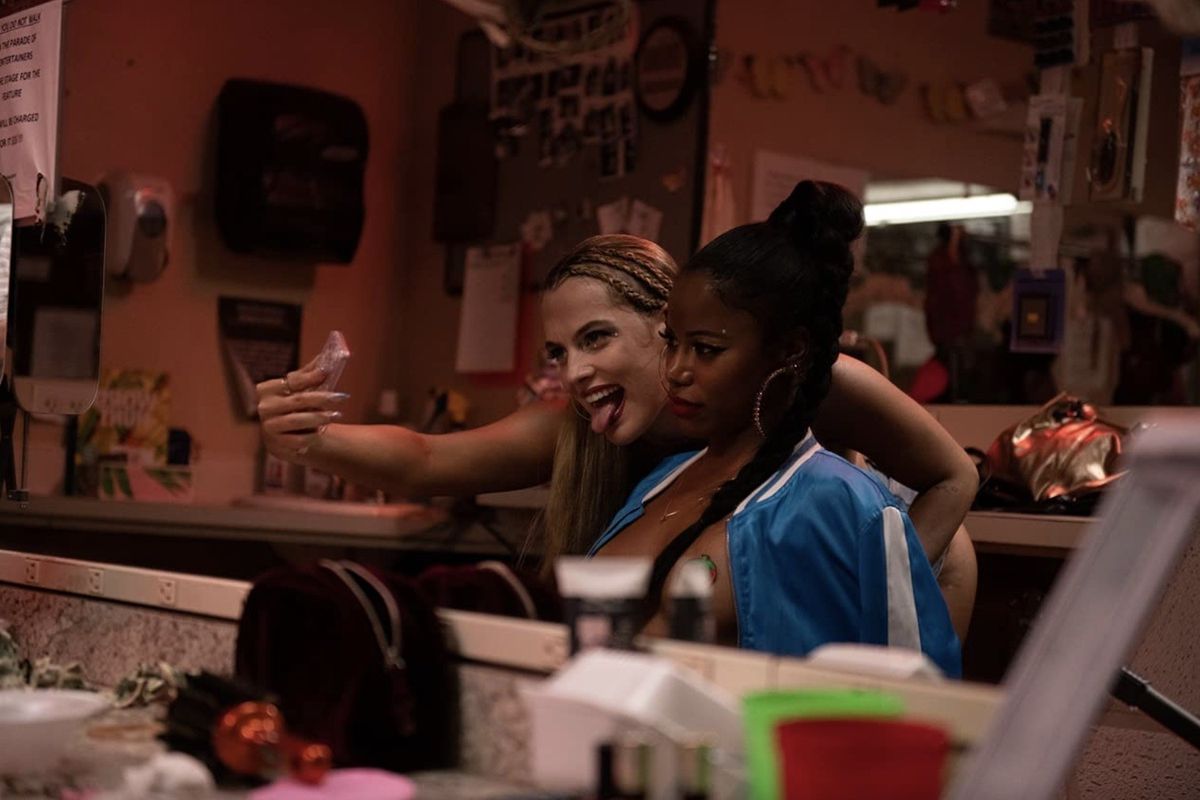
Zola scene white woman posing with Black woman
Photo Credit: Anna Kooris of A24 Films

Janiczo Bravo has made a name for herself as a Black filmmaker who specializes in depicting the absurdity of whiteness. In 2016, she directed the stellar Atlanta episode “Juneteenth,” which depicts a fancy Juneteenth party steamrolled by an overzealous white man who believes his Black wife gives him proximity to the culture. In 2017’s Lemon, Bravo told a story of a white man (Brett Gelman) so insecure about his artistic standing that he lashes out at a younger white actor (Michael Cera) by spray painting “white nigger” onto his car. This is obviously projection, exemplified by his pursuit of a Black woman played by Nia Long as he searches for validation and cultural relevance. Beyond the narrative, Bravo’s aesthetic choices provide viewers with a funhouse mirror image of life, where everyone’s insecurities are easily detected and white clownery is always on display.
Her new feature, Zola, (out June 30th) is based on the infamous viral twitter thread from 2015: the story of a young stripper named Zola (Taylour Paige) who meets Stefani (Riley Keough) at her service job, and forms a fast friendship over their shared profession. Almost immediately, Stefani invites Zola on a cross-country trip to a club in Florida where she guarantees that they will each make five grand in one night. The very next day, Zola leaves her live-in boyfriend Sean (Ari’el Stachel) and travels to Florida with three virtual strangers: Stefani, her boyfriend Derrek (Nicholas Braun) and her “roommate” X (Colman Domingo). Things quickly go awry, as Zola realizes she’s far away from home with a group of emotionally volatile people whose erratic behavior puts her right into harm’s way.

Much of the first half of the film marvels at the grotesque nature of the group’s dynamic, with Zola behaving as an audience surrogate with her clipped, dry responses and bemused expression. But the longer Zola stays with Stefani, the more she realizes that the things she likes about her new friend are simply exaggerated aspects of herself. The film’s poster bolsters this reading, depicting Zola and Stefani looking into each other’s eyes with knowing glances. Stefani presents herself as a mirror image trying her best to be the real thing while Zola is calm and secure in who she is.
Zola is at its best when exploring its white characters Stefani and Derrek, as they perform Blackness when they’re having fun and revert to whiteness whenever circumstances get difficult. At first, there is a glossiness to the film that masks the darkness underneath. But as it goes on, the cuteness begins to dissipate and is soon replaced by the visual language of dread. Mica Levi’s score, which mimics the bells and whistles of social media notifications and iPhone lock screen noises, loses its whimsical charm as it reminds the audience of the falseness of social media. Similarly, Joi McMillon’s editing mimics the quickness of the internet age, reminding us how quickly events can escalate on our phones and in our lives.
And yet, there’s an air of superiority to Zola that’s difficult to shake off. The moral distinction between stripping and more intimate sex work is constantly addressed, positioning Zola as the victim and Stefani as a lost cause. It’s hard to know what Zola aims to accomplish. Are we supposed to be laughing at the white people only or sex workers as well? Stefani is a clown, but she also comes off very troubled. Her performance of Blackness seems to mask a lack of self-confidence, and her relationship with Derrek is emotionally toxic for both of them. I wish I could make these kinds of assessments about Zola herself but we don’t learn much about her or her relationship with Sean. When the couple appears together at the beginning of the film, Zola can’t get her eyes off her phone, with the only exception being when they’re having sex. One night when they’re at dinner before the trip Sean asks: “Am I missing something?” As a viewer, I found myself wondering the same. A more cynical person might guess that Zola staring at her phone during their time together signifies a sense of disinterest, but if films were more truthful there would be many more displays of these moments in romantic and familial relationships. It’s just the truth of our world now, so showing it to us doesn’t actually tell us anything.
That’s where Zola falls short. The film itself does not answer the question of its existence. The Twitter thread was popular but the film never seems to ask why, so what we are left with is a dramatization of the events described with no clear ending or catharsis. This approach to the source material mimics the initial coverage of the thread itself, which saw the woman Stefani was based on dealing with harassment as a result of the carelessness of a media atmosphere that doesn’t care about sex workers. Zola, while fun, fails at interrogating why we consume these stories as entertainment without examining the gray areas that these events tend to live in.
This review was originally published on February 5, 2020
__
Jourdain Searles is a writer, comedian, and podcaster who hails from Georgia and resides in Queens. She has written for Bitch Media, Thrillist, The Ringer, and MTV News. As a comic, she has performed stand-up in venues all over New York City, including Union Hall, The People Improv’s Theater, UCB East, and The Creek and the Cave. She can be found on Twitter.